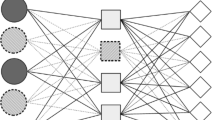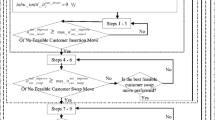Abstract
One of the most applicable techniques in the inventory management field is inventory classification based on ABC analysis, a well-known method to set the items in a different group, according to their importance and values. In this paper, a bi-objective mathematical model is proposed to improve the inventory grouping based on ABC analysis. The first objective function maximizes the total net profit of the items in the central stock, and the second objective function maximizes the total net profit of items in different wards. The proposed model simultaneously optimizes the service level, the number of inventory groups, and the number of assigned items. To solve the model in small and large dimensions, two exact methods (LP-metric and ε-constraint) and two meta-heuristic methods (NSGA-II and MOPSO) are used. Then, to compare those methods in terms of efficiency, the statistical analysis besides the AHP and VIKOR techniques is implemented. The results show the superiority of the ε-constraint among the exact methods and MOPSO among meta-heuristic methods. Finally, the proposed model has been implemented in two sets of numerical examples to demonstrate its applicability.


















Similar content being viewed by others
References
Abdolazimi O, Esfandarani MS, Salehi M, Shishebori D (2020) Robust design of a multi-objective closed-loop supply chain by integrating on-time delivery, cost, and environmental aspects, case study of a tire factory. J Clean Prod 264:121566
Armstrong DJ (1985) Sharpening inventory management. Harv Bus Rev 63(6):42–58
Arrow KJ, Harris T, Marschak J (1951) Optimal inventory policy. Econom J Econom Soc 19:250–272
Asana IMDP, Radhitya ML, Widiartha KK, Santika PP, Wiguna IKAG (2020) Inventory control using ABC and min–max analysis on retail management information system. JPhCS 1469(1):012097
Chen Y, Li KW, Kilgour DM, Hipel KW (2008) A case-based distance model for multiple criteria ABC analysis. Comput Oper Res 35(3):776–796
Chu CW, Liang GS, Liao CT (2008) Controlling inventory by combining ABC analysis and fuzzy classification. Comput Ind Eng 55(4):841–851
Coello CAC, Pulido GT, Lechuga MS (2004) Handling multiple objectives with particle swarm optimization. IEEE Trans Evol Comput 8(3):256–279
Darmanto E, Subanar RW, Hartati S (2019) A new integration of AdaBoost and profile matching algorithm to improve ABC analysis for drug inventory. Int J Sci Eng Res 10(2):779–788
Deb K, Pratap A, Agarwal S, Meyarivan TAMT (2002) A fast and elitist multiobjective genetic algorithm: NSGA-II. IEEE Trans Evol Comput 6(2):182–197
Douissa MR, Jabeur K (2020) A non-compensatory classification approach for multi-criteria ABC analysis. Soft Computing 24(13):9525–9556
Ernst R, Cohen MA (1990) Operations related groups (ORGs): a clustering procedure for production/inventory systems. J Oper Manag 9(4):574–598
Erlenkotter D (1989) Note—an early classic misplaced Ford W. Harris’s economic order quantity model of 1915. Manag Sci 35(7):898–900
Flores BE, Whybark DC (1986) Multiple criteria ABC analysis. Int J Oper Prod Manag 6:38–46
Gong J, Luo Y, Qiu Z, Wang X (2020) Determination of key components in automobile braking systems, based on ABC classification and FMECA. J Traffic Transp Eng (English Edition)
Kaabi H, Jabeur K, Enneifar L (2015) Learning criteria weights with TOPSIS method and continuous VNS for multi-criteria inventory classification. Electron Notes Discret Math 47:197–204
Karimi-Nasab M, Shishebori D, Jalali-Naini SGR (2013) Multi-objective optimisation for pricing and distribution in a supply chain with stochastic demands. Int J Ind Syst Eng 13(1):56–72
Massart P (1990) The tight constant in the Dvoretzky–Kiefer–Wolfowitz inequality. Ann Probab 18:1269–1283
Mehdizadeh M (2020) Integrating ABC analysis and rough set theory to control the inventories of distributor in the supply chain of auto spare parts. Comput Ind Eng 139:105673
Millstein MA, Yang L, Li H (2014) Optimizing ABC inventory grouping decisions. Int J Prod Econ 148:71–80
Ng WL (2007) A simple classifier for multiple criteria ABC analysis. Eur J Oper Res 177(1):344–353
Opricovic S, Tzeng GH (2004) Compromise solution by MCDM methods: a comparative analysis of VIKOR and TOPSIS. Eur J Oper Res 156(2):445–455
Opricovic S (1998) Multicriteria optimization of civil engineering systems. Faculty Civ Eng Belgrade 2(1):5–21
Pareto, V. (1971). Manual of political economy, 1909. English translation by Kelley AM, New York.
Partovi FY, Anandarajan M (2002) Classifying inventory using an artificial neural network approach. Comput Ind Eng 41(4):389–404
Ramanathan R (2006) ABC inventory classification with multiple-criteria using weighted linear optimization. Comput Oper Res 33(3):695–700
Saaty TL (1991) Response to Holder’s comments on the analytic hierarchy process. J Oper Res Soc 42(10):909–914
Shakhsi-Niaei M, Esfandarani MS (2019) Multi-objective deterministic and robust models for selecting optimal pipe materials in water distribution system planning under cost, health, and environmental perspectives. J Clean Prod 207:951–960
Shishebori D, Babadi AY, Noormohammadzadeh Z (2018) A Lagrangian relaxation approach to fuzzy robust multi-objective facility location network design problem. Sci Iran Trans E Ind Eng 25(3):1750–1767
Shishebori D, Ghaderi A (2015) An integrated approach for reliable facility location/network design problem with link disruption. Int J Supply Oper Manag 2(1):640–661
Shishebori D, Jabalameli MS (2013) A new integrated mathematical model for optimizing facility location and network design policies with facility disruptions. Life Sci J 10(1):1896–1906
Stecca G, Baffo I, Kaihara T (2016) Design and operation of strategic inventory control system for drug delivery in healthcare industry. IFAC PapersOnLine 49(12):904–909
Teunter RH, Babai MZ, Syntetos AA (2010) ABC classification: service levels and inventory costs. Prod Oper Manag 19(3):343–352
Yu MC (2011) Multi-criteria ABC analysis using artificial-intelligence-based classification techniques. Expert Syst Appl 38(4):3416–3421
Author information
Authors and Affiliations
Corresponding author
Additional information
Publisher's Note
Springer Nature remains neutral with regard to jurisdictional claims in published maps and institutional affiliations.
Rights and permissions
About this article
Cite this article
Abdolazimi, O., Esfandarani, M.S. & Shishebori, D. Design of a supply chain network for determining the optimal number of items at the inventory groups based on ABC analysis: a comparison of exact and meta-heuristic methods. Neural Comput & Applic 33, 6641–6656 (2021). https://doi.org/10.1007/s00521-020-05428-y
Received:
Accepted:
Published:
Issue Date:
DOI: https://doi.org/10.1007/s00521-020-05428-y




